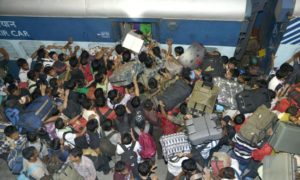India a nomad nation
India’s population is now one of the most mobile in the world with more than 450 million people having migrated to live somewhere other than their home districts, according to a new analysis.
Researchers Amitabh Kundu and P. C. Mohanan have used data from India’s Economic Survey 2017 and rail ticket sales to discover new evidence that indicates Indians are much more mobile than it was generally believed.
“The 2011 Census, rail traffic data and changes in population in different age categories show that migration is much larger than what has been argued by using traditional sources of data like the National Sample Survey (NSS) and the population census,” the researchers says.
“More importantly, there seems to have been an upsurge in mobility for economic reasons in the recent decade across states,” they say.
 Kundu and Mohanan’s research shows the number of migrants by place of last residence in India was 314.5 million in 2001.
Kundu and Mohanan’s research shows the number of migrants by place of last residence in India was 314.5 million in 2001.
That figure rose to 453.6 million in 2011, showing an addition of 139 million, an average of about 14 million migrating every year.
“This is against the figure of 82 million migrants added during 1991-2001, implying that the decadal growth in migration has gone up from 35.5 per cent during 1991-2001 to 44.2 per cent during 2001-11,” the researcher say.
They say that traditionally, inter-state migrants have been only a small percentage of the total migrants in India.
But their analysis uses unconventional data sources and innovative analytics, thereby creating new avenues of research.
They have determined that as many as 27% of all inter-state migrants are 20-29 years old, indicating that those moving for employment reasons is as high as 32 per cent, not 20 per cent as assumed by previous studies.
“Using a more appropriate scaling factor, the number of migrants as per the cohort method would be around 34 million,” the researchers said.
“The rail travel data generated from ticket sales for unreserved class between stations is a rich source,” they said.
“This information for 2011 has been used with a heroic assumption that this class of travel between stations beyond a certain distance, after netting out the travels in the reverse direction, is for employment.
“Usage of different modes of travel for different journeys and complexities in travel patterns of labour and non-labour migrants — partly due to inadequacies of rail infrastructure, besides the absence of the information on the purpose of travel in the data — would significantly reduce acceptability of the findings.
“Notwithstanding all these, the survey has determined the volume of inter-state movement to be nine million a year. This figure is way above the figures arrived at by using more reasonable assumptions in migration literature.
“Importantly, any acceleration in recent internal migration is to be reflected in the number of migrants reporting less than 10 years of stay,” the researchers said.
They said 2011 Census data showed that the migrants reporting over 10 years of stay have increased faster than those of all durations, at around 71 per cent.
“Also, the increase in the number of net rural to urban migrants, reporting a duration of stay more than 10 years, is 70 per cent, much higher than 45 per cent reported for less than 10 years’ duration.
“Correspondingly, the figures for net rural and urban migration for employment reasons are 56 per cent and 31 per cent respectively,” they said.
These figures support the existing view of a decline in the share of migrants in urban growth.
Finally, the percentage of migrants who did not report their duration of stay had risen from 8 per cent to 13 per cent in rural areas, and from 9 per cent to 17 per cent in urban areas.
“Reported hostilities against recent migrants and discriminatory policies of state and local governments explain their not admitting their short duration of migration,” the researchers said.
Laurie Nowell
AMES Australia Senior Journalist












